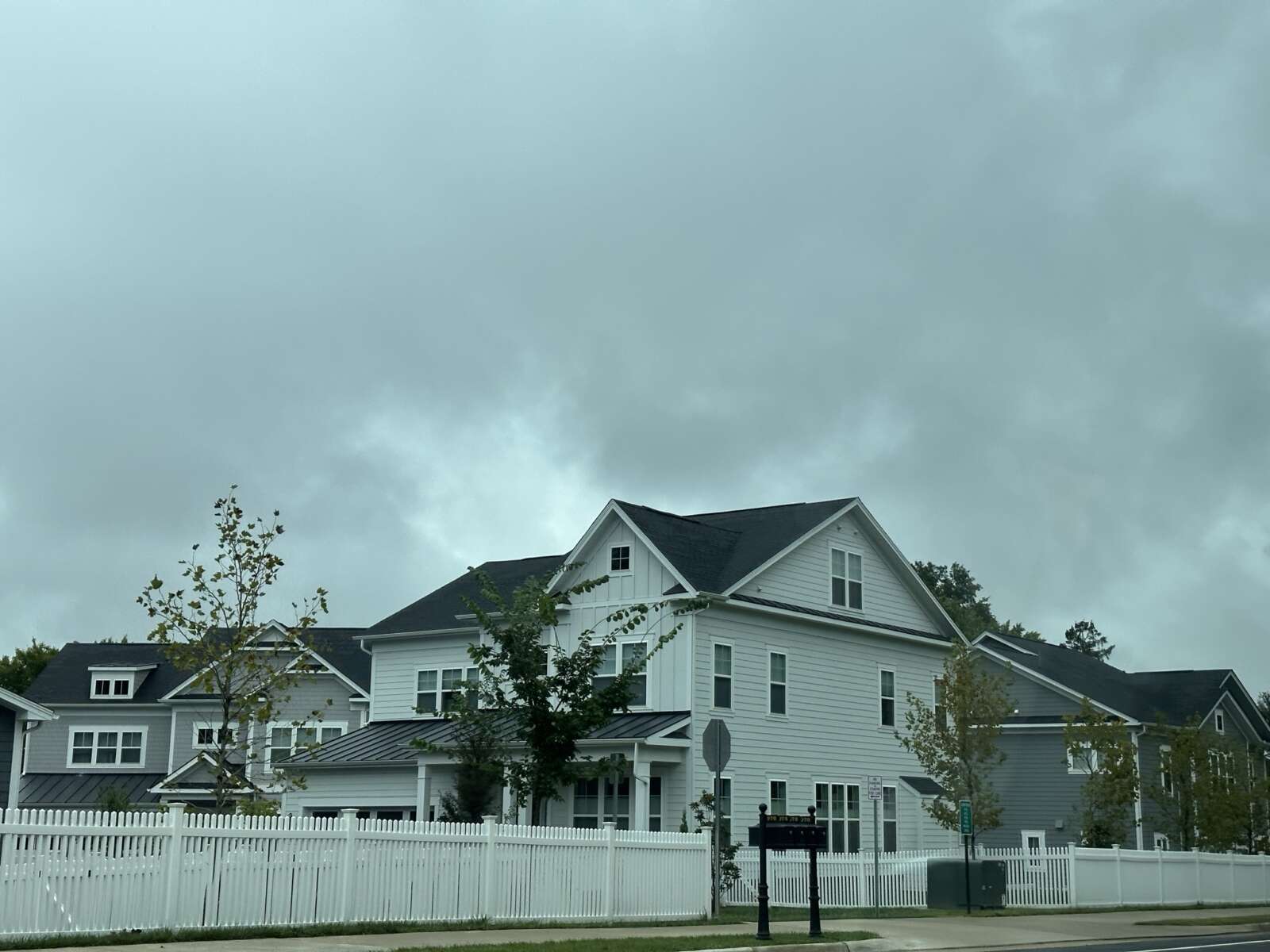
In their quest to boost the region’s limited housing supply, Northern Virginia leaders have explored a variety of potential solutions.
Arlington and Alexandria in particular garnered plenty of headlines — and legal scrutiny, in the county’s case — when officials voted separately last year to allow more dense housing in areas previously reserved for single-family detached homes, among other zoning reforms.
Fairfax County, however, has no plans at the moment to follow in its neighbors’ footsteps by eliminating single-family-only zoning, according to Board of Supervisors Chairman Jeff McKay.
Instead, the county hopes to increase and diversify its housing stock with more targeted policies, such as looser rules for accessory living units (ALUs) and workforce housing requirements, that can accommodate the different character and needs of different neighborhoods.
“Every county and city is different, and so, I’m not in a position to critique what Arlington and Alexandria have done,” McKay told FFXnow. “But we’ve been careful in Fairfax County to make sure that we can grow our affordable housing base and, at the same time, protect the integrity of our single-family neighborhoods…They’re in a different place [in their development schedule], and so, they have reached the point where they believe the only way they can address the ‘Missing Middle’ is to eliminate single-family [only] development. We are nowhere close to that point in Fairfax County.”
Size matters
The D.C. metropolitan area ranks 10th in the U.S. for “pent-up housing demand” due to a lack of supply and elevated mortgage rates, according to the National Association of Realtors. The tight supply fuels high prices that are expected to keep rising in 2024, peaking in June at a median of $935,930 for a single-family house, per a Northern Virginia Association of Realtors and George Mason University forecast.
Faced with limited space for new development, proponents of Arlington’s “Missing Middle” zoning changes and Alexandria’s “Zoning for Housing” initiative argued that opening up single-family-exclusive lots to different types of housing, such as duplexes and townhouses, will allow more units to be built, easing market pressures that have sent median single-family sales prices soaring over $1 million in both localities.
Though those measures didn’t exactly pass with ease, eliminating single-family-only zones in a place of Fairfax County’s size would be “a little bit more challenging,” says Jill Norcross, executive director of the nonprofit advocacy group Northern Virginia Affordable Housing Alliance (NVAHA).
“There’s just a lot more people, a lot more housing units and communities,” she said.
Of the 426,412 housing units in the county as of 2022, 46.1% are single-family detached houses, while 29.6% are multi-family residences and 24.2% are single-family detached homes, per the county’s most recent demographic report. In comparison, Arlington and Alexandria, respectively, are about 70 to 75% multi-family housing.
Parts of Fairfax County are dominated by single-family houses, which range from the mansions of McLean and Great Falls — the kind that Arlington leaders have said they’re trying to avoid — to older, smaller ranch-style or split-level homes like those found in Annandale or Groveton. Then, there are areas like Reston, where more than 80% of homes are townhouses, apartments or condominiums, according to Hunter Mill District Supervisor Walter Alcorn.
That variety means “a one-size-fits-all answer here is no good,” McKay says. Read More
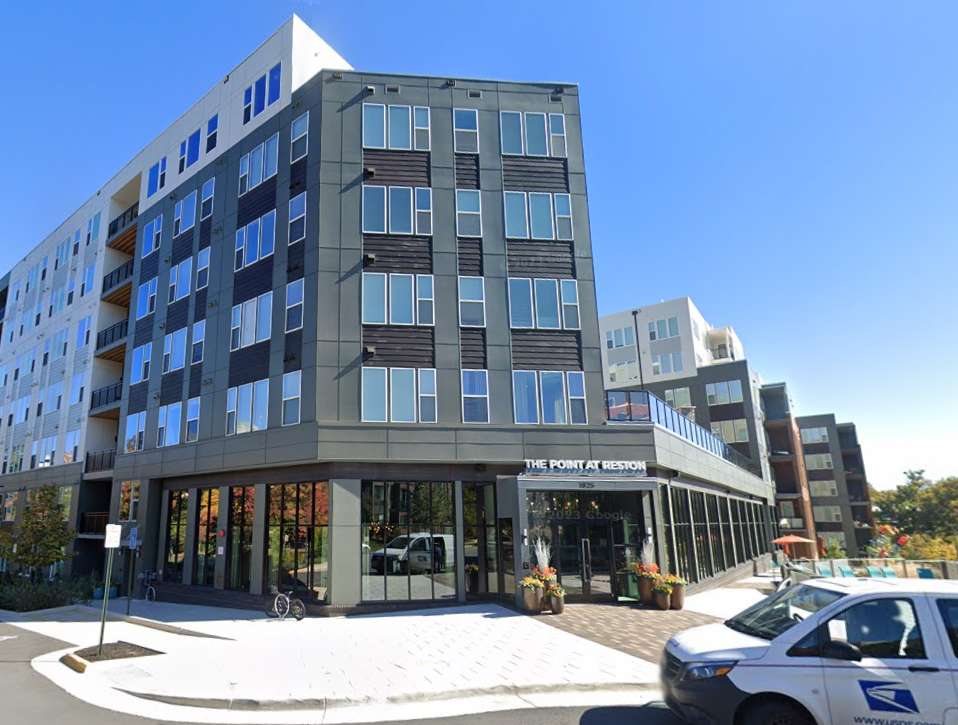
The Hunter Mill District is on track to meet the affordable housing goal set by Hunter Mill District Supervisor Walter Alcorn in March of 2022.
The district, which includes Reston and the Vienna area, has made “some good strides” toward Alcorn’s goal of adding 1,000 affordable housing units by 2027, the supervisor said.
“Currently there are more than 600 affordable units either recently constructed, under construction or scheduled to be constructed soon,” Alcorn said. “This is in addition to the several hundred existing units that are being preserved.”
At the same March 2022 meeting, the Fairfax County Board of Supervisors agreed to double its affordable housing goal by 2034.
Chairman Jeff McKay and Dranesville District Supervisor John Foust introduced a joint motion to set a goal of 10,000 net new affordable units by 2034 and ramp up the county’s resources to reach that goal. Springfield Supervisor Pat Herrity cast the lone vote against the proposal.
As of April 2022, the county had 15,483 committed affordable homes, meaning they’re restricted to designated income levels. Mason District had the most units, followed by Hunter Mill, whose projects have included The Point at Reston and, most recently, The Exchange at Spring Hill Station now under construction in Tysons.
Image via Google Maps

Jimmy Bierman officially stepped into the role of Dranesville District supervisor last week, taking the reins from John Foust, who retired last year after 16 years on Fairfax County’s board.
Bierman, a lawyer and McLean resident, has a clear vision for his tenure, but he says he’s also committed to continuing the work of his predecessor, focusing on issues such as the revitalization of downtown McLean, senior living opportunities and the impact of the I-495 expansion on local residents.
“I had gotten to know John Foust very well, through local Democratic Party circles,” Bierman told FFXnow. “He was really a mentor to me, and a role model.”
Before securing his victory last November against Fairfax County Republican Committee first vice chair Puneet Ahluwalia with 61% of the vote, Bierman served on the county’s Police Civilian Review Panel from April 2019 to December 2022 and worked as an attorney advisor to the U.S. Department of Homeland Security.
But Bierman wanted to do more at the local level.
“I loved my job at federal government, but I started realizing that the government that interacted with people sort of on a day-to-day basis, that you really needed at times, was your local government,” he said.
For his first term representing the Dranesville District, which covers McLean, Great Falls, Herndon and Idylwood, Bierman’s priorities include adopting more environmentally friendly practices, enhancing housing density in areas well-served by public transit and securing additional funding for Fairfax County Public Schools.
Sustainability
At the top of his list is managing the county’s growth in a “sustainable way.”
While in office, Bierman says he plans to not only advocate for conserving green space, but also promoting green practices in county-owned buildings. Specifically, he will focus on incentivizing more renewable energy sources in both the public and private sectors.
“A good example of something that the county did recently in our district, that I very much applaud and think is great, is we’ve moved to powering the Spring Hill Rec Center, partially, through geothermal energy,” Bierman said.
The recreation center at 1239 Spring Hill Road is one of a growing number of county facilities that are getting power from renewable energy.
In July 2021, Fairfax County adopted an Operational Energy Strategy, aiming to become carbon neutral by 2040 through renewable energy practices.

For the first time this century, Fairfax County’s Mason District has a new supervisor.
In his first week since succeeding Penny Gross, who retired in December after 27 years in the position, Andres Jimenez says he has been actively engaging with constituents to tackle issues ranging from transportation to art projects and economic development.
An immigrant from Bogota, Colombia, who has now lived in the Falls Church area for 12 years, Jimenez is the first Latino to represent Mason District on the Fairfax County Board of Supervisors. He also works as the executive director of the pay equity campaign Green 2.0 and previously served as an at-large member of the Fairfax County Planning Commission.
Winning a decisive victory last November over independent candidate Terry Modglin with 72% of the vote, Jimenez says that, since taking office on Jan. 1, he has been setting up his various social media channels, launching a new podcast and organizing several public forums across the district.
“I think that smart government is when residents don’t just come to you, it’s when the government — when the supervisor’s office — is going into the community and reaching out to residents…and asking them what is working, what’s not working, because only then can you really begin to make change,” he told FFXnow.
The dates for the public town hall and open house events have not been announced yet. However, Jimenez anticipates key areas will include transportation, housing and economic development.
“We do plan to go out into the communities [and] listen to the residents and make sure that we are prioritizing the needs of Mason District,” he said.
Pedestrian and traffic safety
Top on Jimenez’s agenda is addressing pedestrian and traffic safety concerns in neighborhoods like Annandale, Bailey’s Crossroads and Seven Corners.
Last year, the community advocacy group Fairfax Families for Safe Streets published a report showing that pedestrian fatalities increased in 2022 as a result of “underfunding for pedestrian-focused projects.”
“Unfortunately, there have been a lot of fatalities when it comes to the pedestrians,” Jimenez said. “…We need to really start working on figuring out not only why is this happening, but how can we solve this problem.”
In 2021, the Board of Supervisors approved $100 million for county-wide pedestrian and bicycle infrastructure improvements that will be allocated to different projects through 2028. About $30.2 million has been allocated to date, according to the county website.
At the moment, the county is reviewing 69 proposed safety projects proposed for Mason District. Each of the projects originated from resident suggestions through a county-led online survey.
Jimenez emphasized his objective is to ensure that money is promptly allocated to projects in Mason District, adding that the money is “desperately needed.”
Jimenez identified a few intersections — such as Leesburg Pike (Route 7) at both Row Street and Columbia Pike — as high priority, focusing more on signal upgrades and other spot improvements than more comprehensive, long-term solutions.
In the coming months, Jimenez noted that he plans to consult with local stakeholder groups, such as the Bailey’s Crossroads 7 Corners Revitalization Corporation, to help identify projects that need immediate attention.
“We’ve already identified several initiatives — obviously Seven Corners, Bailey’s Crossroads and Annandale — that need help,” he said. “They need signage and they need timers and they need different ways to make sure that pedestrians are safe.”
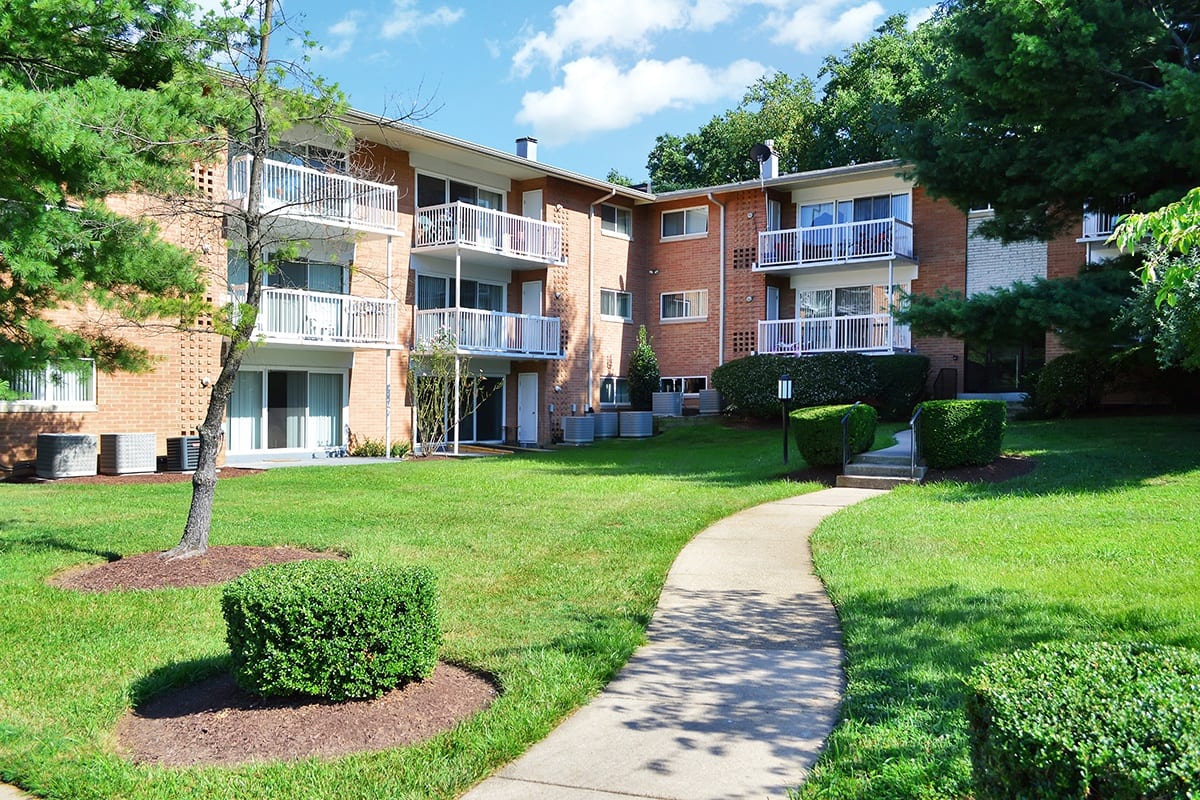
The affordable housing developer behind the new Lake Anne House in Reston is targeting an apartment complex near Falls Church High School for a similar rebuild.
Enterprise Community Development, a Maryland-based national nonprofit, announced last week that it has acquired the Coralain Gardens Apartments in West Falls Church for $21.7 million, setting the stage for a rehabilitation that will enable the property to remain fully affordable.
Located at 7435 Arlington Blvd, the 10 three-story apartment buildings were built in 1964 and consist of 106 studio and one or two-bedroom units — all of them reserved for residents who earn 60% of the area median income (AMI) or below.
Now 60 years old, Coralain Gardens was at risk of losing its income restrictions, but Enterprise Community Development has committed to preserving them through 2087, according to a press release.
“The acquisition of Coralain Gardens was a wonderful chance for Enterprise Community Development to make a positive impact on the Fairfax community,” Enterprise interim president Christine Madigan said. “We are grateful for the County’s partnership and leadership in affordable housing preservation. We are looking forward to renovating the property and ensuring it remains a great place to live for both current and future residents.”
Enterprise says it will seek federal tax credits to fund “a full-scale rehabilitation” of the apartments, a project expected to start by the first quarter of 2025.
The acquisition was financed with a senior mortgage from a Low Income Investment Fund (LIIF) and Capital Impact Partners (CIP) partnership. Enterprise also assumed an existing loan that the Fairfax County Redevelopment and Housing Authority (FCRHA) had on the property.
The nonprofit was chosen for the deal from the county’s Preservation Partner Pool, a list of housing providers created last year to streamline the process of identifying developers and funding for projects to preserve affordable housing.
In parallel with its efforts to add 10,000 new affordable housing units by 2034, the Fairfax County Board of Supervisors adopted an affordable housing preservation policy last year that incentivizes developers to replace both income-restricted and market-rate affordable units.
The Preservation Partner Pool was formed to help implement that policy, which also gave developers the option to provide the replacement units off-site if building them on the redeveloping site isn’t feasible.
“The Preservation Partner Pool enables Fairfax County to quickly act on preservation opportunities that arise, such as this opportunity to purchase Coralain Gardens,” FCRHA Deputy Director of Real Estate Development and Finance Anna Shapiro said. “Enterprise was selected…because of their commitment to extend the existing affordability and invest in physical improvements to the property. The benefits of this acquisition will be realized for years to come for current and future residents.”
Enterprise completed its $86 million Lake Anne House at 11444 North Shore Drive last summer. The 240-unit apartment complex for low-income seniors replaced Lake Anne Fellowship House, which had provided affordable housing for older Reston residents since 1970.
Enterprise owns 114 communities across the U.S. that collectively house 23,000 people.
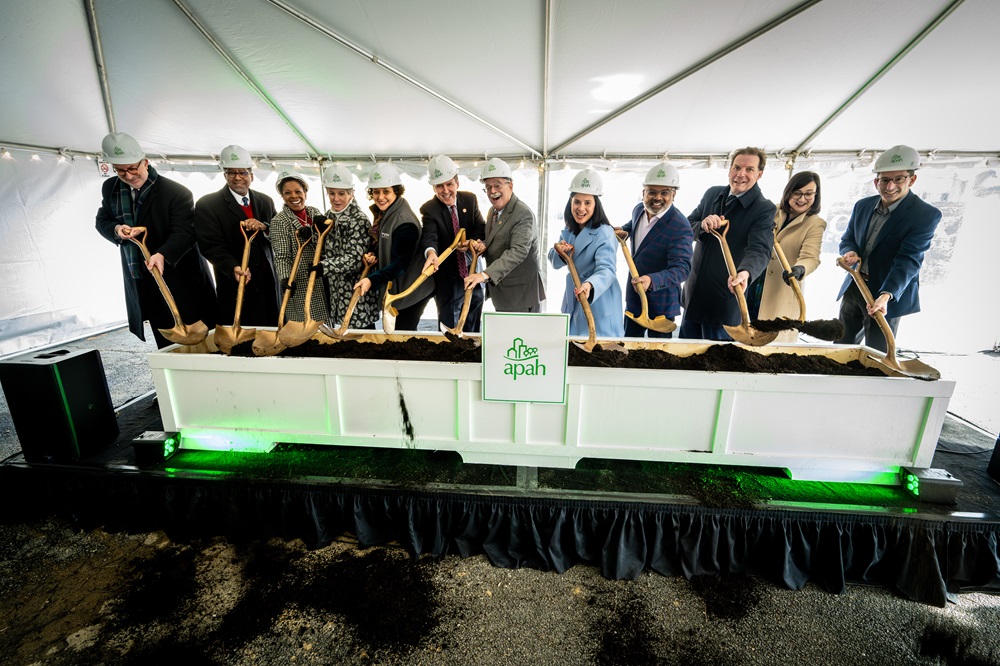
Construction has begun on a development that promises to bring hundreds of affordable housing units to Tysons.
Officials with Fairfax County, nonprofit developer Arlington Partnership for Affordable Housing (APAH) and other partners broke ground yesterday (Tuesday) on the Dominion Square project, which has been newly renamed The Exchange at Spring Hill Station.
Accelerated by a $55 million grant from Amazon, the development will consist of two 20-story apartment buildings with a total of 516 residential units and a new community center for Tysons. Located next to a Land Rover and Jaguar auto dealership, the housing complex will be reserved for residents earning 70% of the area median income (AMI) or less.
That focus on lower-income residents makes the project especially valuable in Tysons, Fairfax County Board of Supervisors Chairman Jeff McKay said during the groundbreaking ceremony, whose attendees included Rep. Gerry Connolly.
“Despite its economic muscle, Tysons has remained out of reach for many who work here to also live here,” McKay said. “That is why the groundbreaking of The Exchange at Spring Hill Metro is so important. We are providing homes for those who fuel the local economy. In order to remain the economic hub of Fairfax County, Tysons’ workers need to have the opportunity to live near where they work.”
According to APAH, which is leasing the land from the Fairfax County Redevelopment and Housing Authority, there will be 112 one-bedroom units, 306 two-bedroom units and 98 three-bedroom units. Units will be priced for households at varying incomes is as follows:
- 100 units for 30% AMI
- 125 units for 50% AMI
- 175 units for 60% AMI
- 116 units for 70% AMI
There will also be 100 units available through the FCRHA’s project-based voucher program.
This is the first fully affordable housing project to be built in Tysons, according to APAH President and CEO Carmen Romero.
“The residents who will call The Exchange home will have access to a vibrant and rapidly growing community full of opportunity and resources,” Romero said. “Yes, where you build matters, but who you build for matters just as much.”
Operated by Fairfax County Neighborhood and Community Services, the 30,000-square-foot community center will be free and open to the public. Planned amenities include a basketball court and fitness center.
Expected to be finished in approximately four years, construction on The Exchange comes amid a general uptick in activity in western Tysons, which has been slower to develop.
This summer, the Board of Supervisors approved an office-to-residential swap at the Highline at Greensboro District, and a conversion of the Sheraton Tysons Hotel in Tysons West is poised for a vote in January. In addition, the recent closure of three auto dealerships near the Spring Hill Metro station may have set the stage for redevelopment of Dominion Square East, which will be part of the same neighborhood as The Exchange.
In a press release, APAH shared more reactions to the project from yesterday’s groundbreaking: Read More
The potential benefits and challenges of converting commercial properties into housing both emerged during a public hearing last week on a proposal to repurpose the now-vacant Sheraton Tysons Hotel at 8661 Leesburg Pike.
Promising up to 544 new residential units, the project will boost the supply of housing in Tysons with a unique, market-rate affordable option, a representative for developer JBG Tysons Hotel touted at the hearing before the Fairfax County Planning Commission on Thursday (Dec. 14).
Because the development will utilize the existing hotel structure, the majority of units — about 80% — will be smaller-than-average studios, a currently “underrepresented” housing type, according to Walsh Colucci land use attorney Robert Brant. Some one and two-bedroom units will also be included, along with designated workforce dwelling units.
“This is an opportunity to provide diversity in the range of housing. The smaller units, combined with the fact that this is adaptive reuse, will make them also naturally more affordable,” Brant told the commission. “…Folks will be able to have an affordable housing option right here at the doorstep of the Spring Hill Metro station.”
The planning commission recommended that the Fairfax County Board of Supervisors approve the conceptual development plan, which will amend a plan for the Tysons West neighborhood that was originally adopted in 2013 to allow the hotel-to-residential conversion.
The developer is also seeking to revise a second planned, but unbuilt residential building along Leesburg Pike (Route 7) from a 400-unit, six-story mid-rise to 265 units with five to eight stories and 5,000 square feet of retail. The overall height of 85 feet would stay the same.
The smaller footprint for “Building C” preserves the top portion of the existing hotel parking garage and provides more room for park space, getting Tysons West up to the 3.05 acres of publicly accessible urban park space required by the county.
However, whether that space will actually meet the needs of future residents and surrounding community remains a question mark.
“We would say definitely the applicant has made improvements in terms of the quantity of park space. We remain concerned about the quality and functionality of the park spaces,” Fairfax County Park Authority Assistant Director of Planning and Real Estate Sam Hudson said.
Eight park spaces are proposed for the 16-acre development, mostly pocket parks and urban plazas along Cornerside Boulevard. FCPA staff told the planning commission that not all of the plazas meet the minimum size for a “civic plaza” under the county’s urban parks framework. Read More
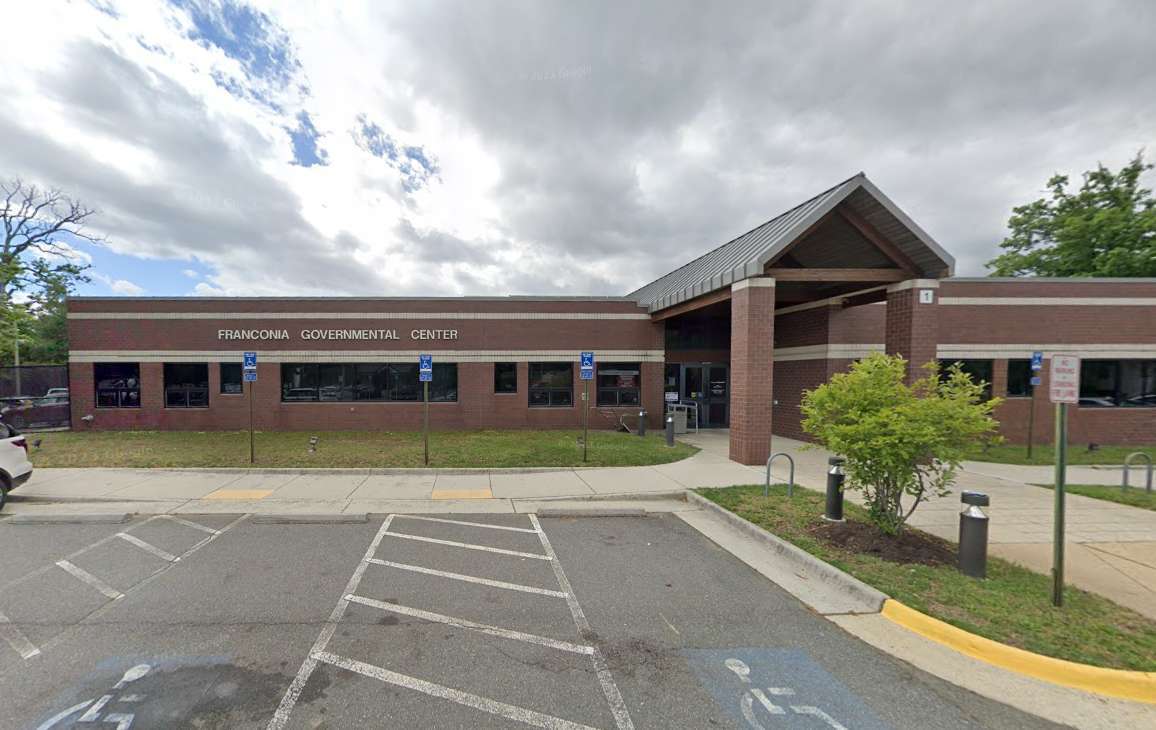
A plan to redevelop the site of the Franconia Governmental Center into an affordable housing development won’t move forward until the new year.
At a meeting last Tuesday (Dec. 5), the Fairfax County Board of Supervisors deferred a decision to transfer the nearly 3-acre property at 6121 Franconia Road to the Fairfax County Redevelopment and Housing Authority (FCRHA).
Franconia District Supervisor Rodney Lusk moved to defer a decision on the conveyance to Jan. 23.
FCHRA is currently negotiating with a developer to expand the county’s affordable housing portfolio by building apartments on the property.
The land transfer previously got a public hearing and the board’s approval in March 2021, but staff said in a Dec. 5 memo that unidentified concerns were raised about the “validity” of the hearing.
“Although staff does not share these concerns, this item is intended to fully address this issue by both validating the original conveyance, and in an abundance of caution, repeating the public hearing,” staff wrote.
The county issued a request for proposals from developers in February of last year. The request stated that the future development should have up to 120 residential units.
The FCHRA is set to complete a public hearing on the interim agreement for the proposal on Thursday, Dec. 14, with the intention to execute the agreement on Jan. 18.
The Franconia Government Center is in the process of being relocated. Construction on the new facility began last year, and it’s expected to be ready for occupancy in early 2025, according to the project page.
Image via Google Maps
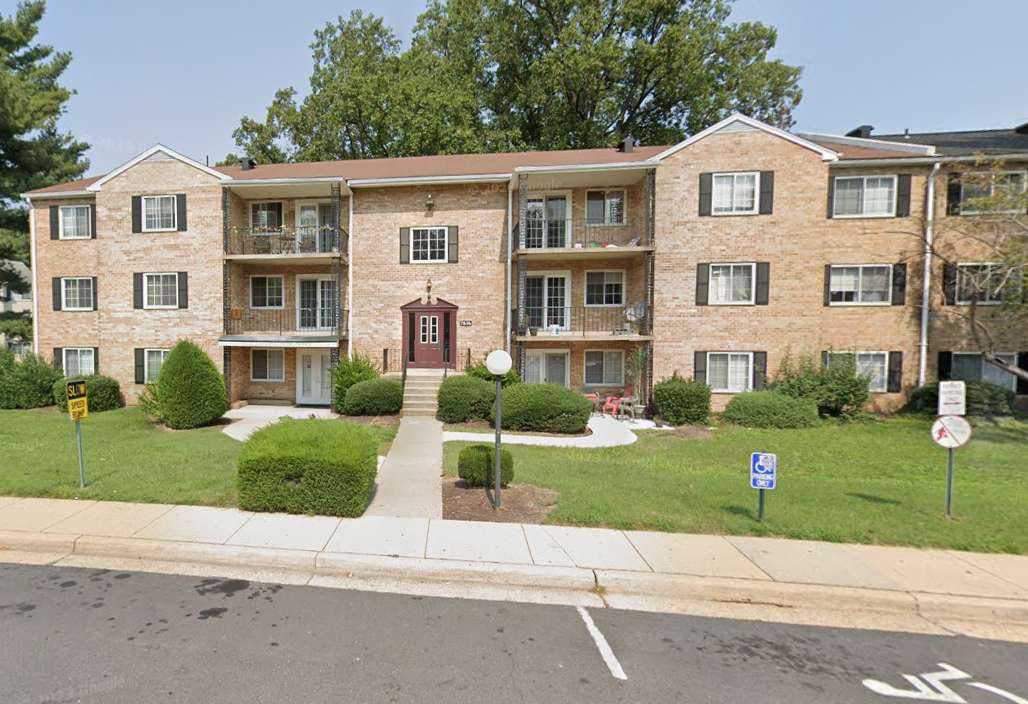
Fairfax County is looking to update its guidelines for how rental and mobile home developers can assist displaced tenants for the first time in a decade.
Director of Fairfax County Department of Housing and Community Development Tom Fleetwood presented the proposed guidelines to the Fairfax County Board of Supervisors at a housing committee meeting last week (Nov. 28).
“The goals are to maintain our commitments to affordable housing, to ensure that as many of our existing residents who depend on affordable housing are able to stay in it, and that we’re able to also move forward with redevelopment as we need to,” Fleetwood said.
Last updated in 2012, the Relocation Guidelines provide a plan for residential developers to follow for multi-family rental buildings or mobile homes that are going to be demolished, rehabilitated or converted.
Under the new guidelines, owners would be required to engage with the existing tenants and develop a relocation plan for them. The guidelines will also apply to all affordable housing owned, managed or funded by the Fairfax County Redevelopment and Housing Authority and properties subject to the Preservation Policy adopted in March.
“Our expectation is that [the developers will] provide moving cost reimbursement and housing counseling, and that they will provide staffing to conduct these activities,” Fleetwood said. “We want the owner to create a property profile so that we understand who’s living there, what the rent rolls look like, what opportunities there are for tenants to move into units that best match their needs.”
According to Fleetwood, another goal is for every tenant who is relocated to be able to return.
“In the event all tenants are unable to return, a priority ranking system tool will help property owners prioritize those with the greatest need,” the presentation said.
For example, priority could be given to a household with children or a disabled person living in it.
Developers could also be required to make up any differences in security deposits.
“If someone has to move, and the security deposit at their new home is higher than their existing security deposit, we would expect that a developer would pay that difference,” Fleetwood said.
Tenants facing permanent and temporary relocation will receive both relocation services and reimbursement of moving costs. Those who have to permanently move would also get relocation payments or a tenant assistance fund that would provide a time-limited rental subsidy.
Mount Vernon District Supervisor Dan Storck questioned how the guidelines and expectations would be enforced, which he said could be one of the biggest challenges.
Fleetwood said there are plans to hire a specialist who will be in charge of monitoring relocation plans.
The county will now conduct outreach and collect feedback before releasing a revised draft of the new guidelines next April. The proposal will be submitted for the board’s final approval in June.
Image via Google Maps
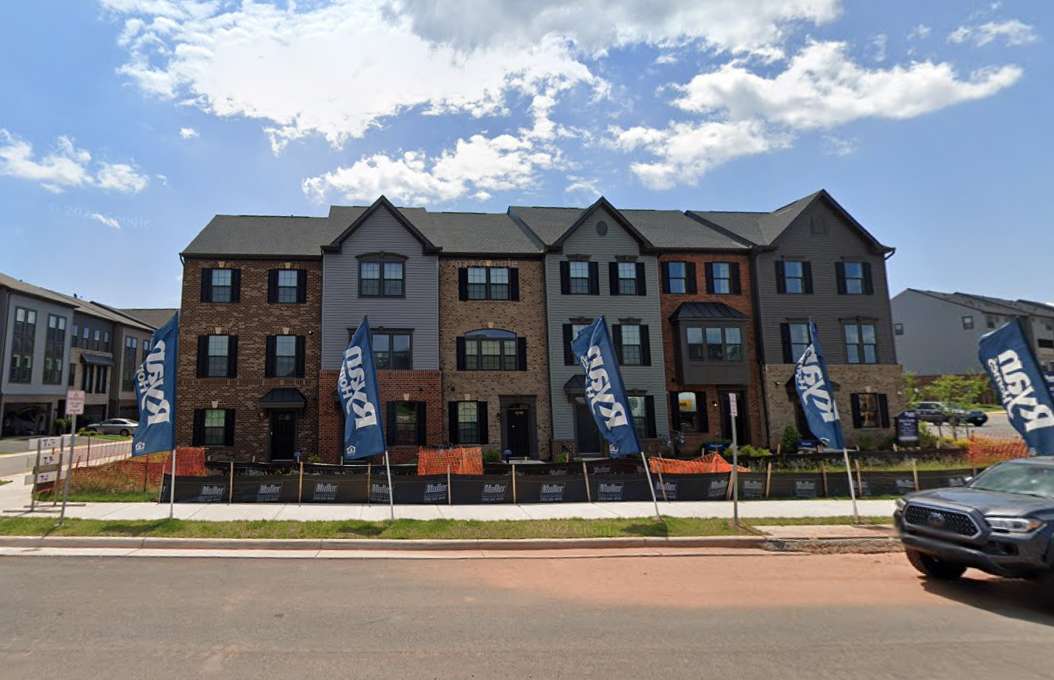
In the future, people who earn more than Fairfax County’s median income will likely no longer be able to buy workforce housing.
A task force recommended to the Board of Supervisors housing committee on Tuesday (Nov. 28) that the top income bracket be dropped from the Workforce Dwelling Unit (WDU) Homebuyer Program, which currently provides price-controlled townhouses and condominiums to people who make 80% to 120% of the area median income (AMI).
Building on a revision of the county’s rental WDU program in 2021, the task force proposed dropping the 120% AMI tier and adding 70% AMI households — which are already offered at some properties — as part of a general policy overhaul intended to make the homebuyer program more efficient and effective.
“The recommendation that came out of the task force was really to reset the program and shift everything down by a third,” Anna Shapiro, the county’s deputy director of real estate finance and development, said. “…It was recognized that there is a financial impact to resetting the program, but it would be balanced by the predictability of having the policy reset in a way that developers understood going into the program what they’d be required to do.”
Initiated by the Board of Supervisors in February, the 13-person WDU For-Sale Policy Task Force included county staff, residential developers, affordable housing advocates and other industry experts. With help from the consultant HR&A Advisors, it met from April to October to evaluate the existing program, research best practices and develop recommendations for improvements.
Right now, the county grants residential developers bonus density if they designate at least 12% of all units as affordable or workforce housing, except in Tysons, which has higher requirements. For WDUs, the countywide policy requires that 4% of the total units target each of the 80%, 100% and 120% AMI tiers.
According to Shapiro, the 120% AMI WDUs are more difficult to sell, staying on the market for 419 days on average — almost twice as long as even the 100% units, which average 235 days. In comparison, units at 70% and 80% AMI sell in around 74 and 104 days, respectively.
In general, the county’s supply of for-sale WDUs is limited, but of the 12 units for 120% AMI that have been produced, 42% remain unsold. The lack of demand reflects stronger competition from market-rate housing, Shapiro explained, noting that 46% of the homes sold in the county since 2020 are affordable to those in the 100-120% AMI range.
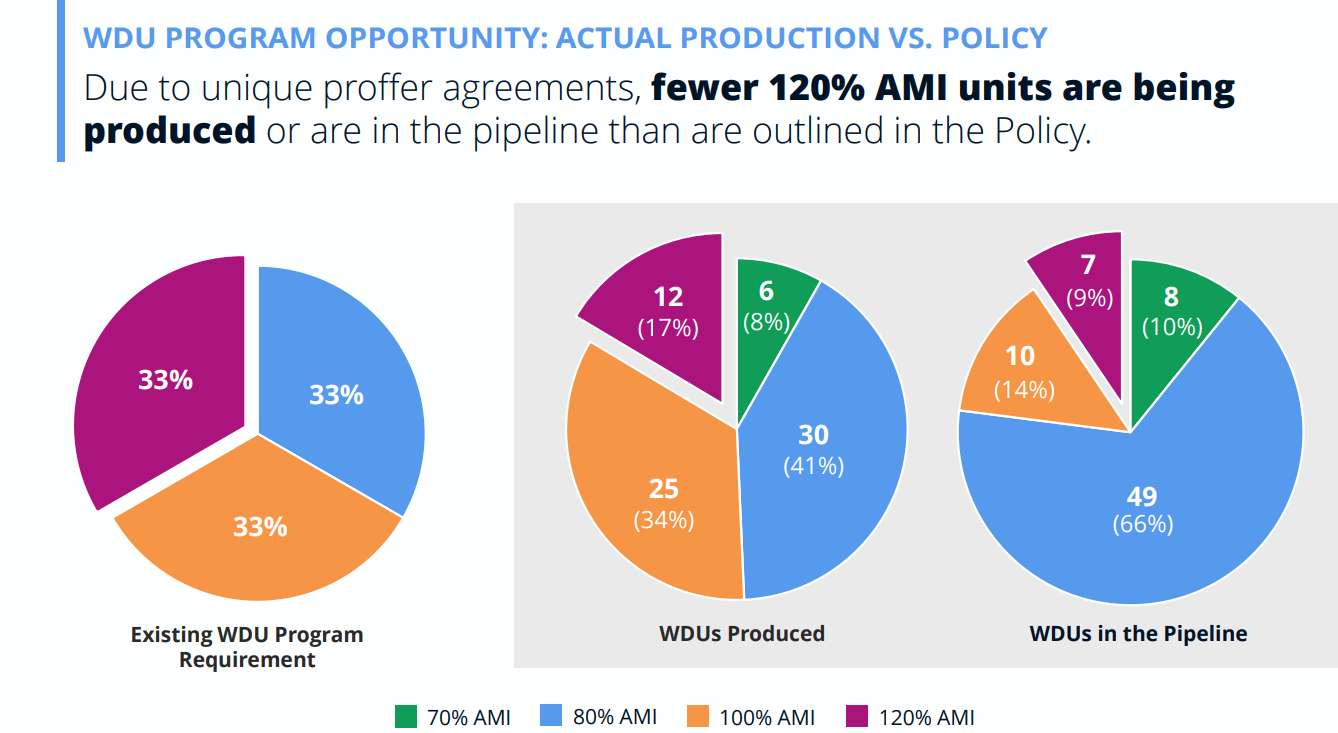
With developers shouldering the cost of any unsold units, they have shifted toward units aimed at lower income levels during proffer negotiations, where the county can set conditions for a project’s approval.
“There is a huge demand that we see for units below 80% AMI, so we really wanted to see how we can serve that population better,” Shapiro said.
In addition to adjusting the AMI range, the task force recommends requiring that the number of WDUs with three or more bedrooms be proportional to the number of similarly sized market-rate units.
“If you then produce a lot of two and three-bedroom market rate units but then a lot of your WDUs are one-bedroom or studio, it’s really an equity issue as well as a marketability issue for the property,” Shapiro told the committee. Read More

